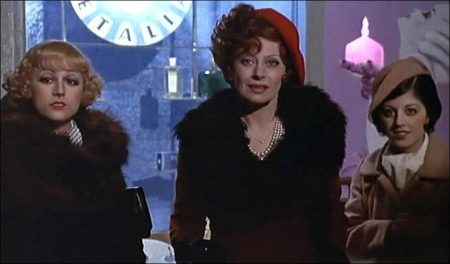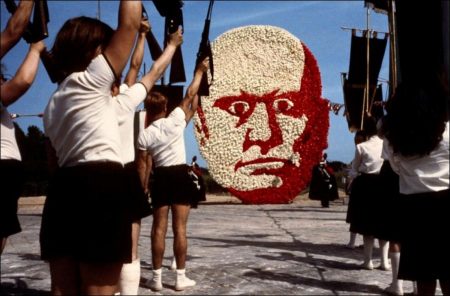Taglines: The Fantastic World of Fellini!
Amarcord (A m’arcord), a semi-autobiographical film, takes its name from the pronunciation of the word “mi ricordi” in Rimini, the town where Federico Fellini was born and raised. We call it semi-autobiographical, because it denies that Fellini is autobiographical, but on the one hand admits that it consists of memories. I think Amarcord is an Italian film in every way. The film by the Italians, Rimini, Fellini…
Amarcord opens with pollens that herald the arrival of spring in the Mediterranean. Interestingly, on a spring evening full of pollen, which we learn to call the devil balls, he takes away whatever is to be burned in his village house. A huge fire is made in a manner similar to our hddrelleze. The festivities celebrate the arrival of spring, jump over the fire, and from this moment on, we start to watch sections of Rimini from the eyes of Fellini. Obviously, Amarcord’da, does not revolve around a certain issue, even the leading role Titta (Bruno Zanin) is not fully in the lead role.
Yes, we are mostly watching the life and family of Titta, where Fellini is embodied, but on the one hand we witness the lives stuck in this small town and their dreams. In Amarcord, each character can even be said to be equally dominant. Every character is caricaturized at a strange level… But what makes these characters ordinary in your eyes is that they all exist somewhere in life. The only difference is that Fellini brings them all together. He conveys the remnants of his childhood, sometimes sad, sometimes sarcastic, sometimes fantastic but often funny. That’s why a Fellini-style comedy that makes you laugh a lot.
Amarcord, which took place in Italy in the 1930s, also refers to fascism in these lands where Duce reigns naturally. In these years when Mussolini strengthened his power and laid the foundations of fascism, we see both the love for Duce and the oppression mechanisms of the state in Rimini. How people are uniformized, how contradictory voices are eliminated… However, Fellini reflects this as something so ordinary that even if Titta’s father has not been tortured, it can be said that he is not disparaging.
Because, in fact, in his own way, as in the Black Shirt sequence, he mocks and demonstrates how fascism penetrates Italy. This is due to the fact that Italian fascism differs from Germany, Spain or many other countries and it is a part of Italian life at that time. In the part where Titta’s grandfather was dense fog, the fact that he had said such a fog since 1922 came to my mind as an emphasis on Mussolini. Maybe Fellini referred, maybe he didn’t, but after Mussolini came to power in 1922, it was clear that the country had landed on a fog.
Fellini, who mocked the state with the words of the history teacher in the school, the language of the mathematics teacher and the attitude of the teacher, and the influence of religion on the person and the body in the sequence that Titta confessed, gave us the opportunity to see the Italian life from all sides by going to Titta’s family life. Amarcord in particular, the mischief of Titta and his friends, adolescent states, sexual perspectives, first love, the first disappointment, the first rejection ilgi Even the interest of someone older, uncontrollable sexual desires in the age of the most uncontrollable sexual desires… But generally, people living in a small town dreams, loves, hopes of the future, joys, sorrows, holidays, deaths, crazy states, marriages… From the beginning of spring to the next spring, this is exactly what we have seen in Amarcord.
Amarcord is also a film where you can see Fellini’s women and their fetish spots in abundance. Gradisca (Magali Noel), which came into play at this point, constitutes the most important link of the film after Titta. Although the beautiful Gradisca – of course, Titta – who, of course, has done the wrong things in his time, is a character who wants to get married and have children, to fall in love and to be connected to a man. Fellini depicts this transition in his life in his own unique style and Gradisca, which we see in a very important part of the film in crimson clothes, turns into whites in the snowing sequence.
Gradisca, which we saw before wearing the white in the ship sequence, already talks about his dreams of marriage here, but this detail becomes more evident in the part where he is the wife. The peacock brought to my mind the goddess called Hera in Greek mythology (Junon in Roman mythology), and I thought it reflected the change in Fellini’s character. Because Hera is also the most important symbol of the peacock. Consequently, Gradisca, which evokes love, sexuality and beauty like an Aphrodite in the film until that point, starts to symbolize marriage, femininity and birth like Hera. Indeed, the next sequence confirms this and Gradisca’s life is changing.
In Amarcord there is another detail that is hidden in the section where the sheikh and his 30 wives. At first we thought the character of Arab sheikhs, after entering the hotel is actually impossible not to notice that the hotel has an allusion to Turkey because the Turkish flag in the lobby of four. If the film in 1973 was taken into consideration, although I must say I found it interesting to tell 1930 it is touted to Turkey.
Amarcord005 Adorned with the unique music of Nina Rota, Amarcord is one of the important films of both film history and Fellini filmography, which earned Fellini the Academy Award for Best Foreign Film in 1975 and many other awards. He reminds me of Rome from time to time as we watch his life and human life through the eyes of Fellini, and this film, like Rome, is known as Amar Fellini’s Amarcord zaten. Amarcord, as critically acclaimed as enough to be used as a description, is a fantastic presentation of Fellini’s ordinary world; the reflection of the state, religion, authority and education, which is not sarcastic but ridiculed, but most of all, is a reflection of the fantasy viewpoint… Watch, to get to know Fellini with her childhood memories…
Amarcord (1973)
Directed by: Federico Fellini
Starring: Bruno Zanin, Magali Noël, Pupella Maggio, Armando Brancia, Josiane Tanzilli, Ciccio Ingrassia, Maria Antonietta Beluzzi, Ferruccio Brembilla, Ferdinando Villella
Screenplay by: Federico Fellini, Tonino Guerra
Production Design by: Danilo Donati
Cinematography by: Giuseppe Rotunno
Film Editing by: Ruggero Mastroianni
Costume Design by: Danilo Donati
Art Direction by: Giorgio Giovannini
Music by: Nino Rota
MPAA Rating: None.
Distributed by: PIC Distribuzione (Ialy), Warner Bros. Pictures (International)
Release Date: December 18, 1973 (Italy)
Views: 436




